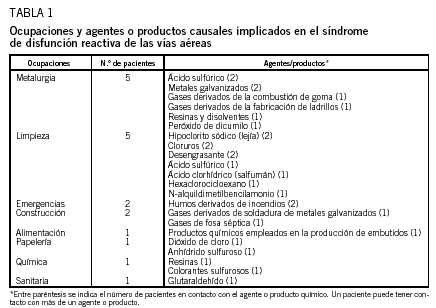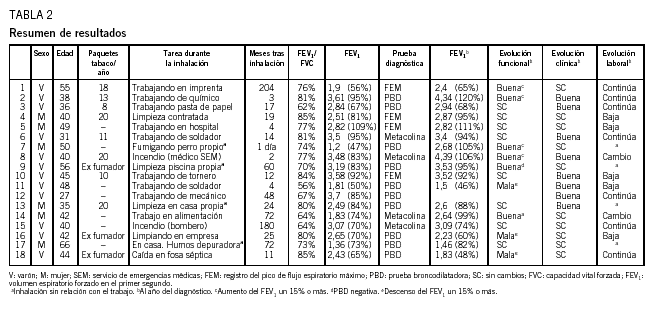Journal Information
Vol. 124. Issue 11.
Pages 419-422 (March 2005)
Vol. 124. Issue 11.
Pages 419-422 (March 2005)
DOI: 10.1157/13072858
Síndrome de disfunción reactiva de las vías respiratorias. Estudio de 18 casos
Reactive airways dysfunction syndrome. A study of 18 cases
Visits
5519
This item has received
Article information
Fundamento y objetivo: Estudio descriptivo y evolutivo de una serie de pacientes diagnosticados de síndrome de disfunción reactiva de las vías respiratorias. Pacientes y método: Estudio retrospectivo de 18 pacientes diagnosticados de síndrome de disfunción reactiva de las vías respiratorias. Se recogieron los datos de la historia clínica, el estudio funcional respiratorio, las pruebas de alergia y las analíticas. Se valoró la evolución clínica, funcional y laboral al año del diagnóstico. Resultados: El estudio incluía 12 varones y 6 mujeres con una edad comprendida entre los 27 y los 66 años. Las actividades implicadas con mayor frecuencia fueron la metalurgia y la limpieza. Los agentes que en más ocasiones estuvieron involucrados fueron sustancias o agentes químicos derivados del cloro y del azufre. El tiempo medio desde la exposición a la aparición de los síntomas fue, en todos, antes de 1 h en 10 pacientes (55%) y antes de las 24 h. Todos los pacientes relataron que habían presentado disnea, 12 (67%) refirieron sibilancias, 8 (44%) síntomas del área otorrinolaringológica, 8 (44%) síntomas sistémicos como, por ejemplo, cefalea y vómitos, y 4 (22%) síntomas oculares. Aunque todos los pacientes habían recibido asistencia médica tras la inhalación, el diagnóstico correcto se retrasó durante meses o años (tiempo medio: 3,6 años). En aquel momento 6 de 18 pacientes (33%) mostraron obstrucción bronquial en las pruebas de función respiratoria. En la evolución clínica presentaron mejoría 8 de 18 pacientes (44%), mientras que el resto quedó sin cambios. En el control funcional 8 de 17 (47%) quedaron estacionados, 6 de 17 (35%) mejoraron y 3 de 17 (18%) empeoraron. De los 14 pacientes en que la inhalación se produjo en el lugar de trabajo, 7 (50%) continuaban trabajando en la misma ocupación, 5 (36%) estaban de baja y 2 (14%) habían cambiado de lugar dentro de la misma empresa. Conclusiones: El síndrome de disfunción reactiva de las vías aéreas a menudo no se sospecha, lo que puede producir un retraso de meses o años en el diagnóstico y en el tratamiento adecuado. Incluso entonces, éste debería considerarse, ya que en más de una tercera parte de nuestros pacientes se demostró una mejoría clínica y funcional.
Palabras clave:
Asma ocupacional
Asma por irritantes
Background and objective: We intended to perform a descriptive-evolutive study of a series of patients diagnosed with Reactive Airways Dysfunction Syndrome. Patients and method: Retrospective study of 18 patients diagnosed with Reactive Airways Dysfunction Syndrome. Clinical data, functional respiratory study, and allergic and laboratory tests were collected. The clinical, functional and occupational evolution one year after diagnosis was evaluated. Results: Twelve men and 4 women aged 27 to 66 years were evaluated. More frequent activities were metallurgy and cleaning, and the related agents were derived from chlorine and sulphur. Time from the beginning of exposure to development of symptoms was 1 hour in 10 (55%) patients and less than 24 hours in all cases. All patients reported to have dyspnea (100%), 12 (67%) wheezing, 8 (44%) nose and throat symptoms, 8 (44%) general symptoms such as headache and vomits, and 4 (22%) ocular manifestations. Although all patients received medical assistance after exposure, a correct diagnosis was made some months or years later (average time 3.6 years). At that time there was an airway obstruction in 6 of 18 (33%) patients. With regard to the clinical evolution, there was an improvement in 8 of 18 (44%) patients, while the rest remained stable. In the functional follow up, 8 of 17 (47%) showed no changes, 6 of 17 (35%) improved and 3 of 17 (18%) worsened. Among the patients who inhaled in the workplace, 7 of 14 (50%) continued working in the same job, 5 of 14 (36%) were off sick and 2 of 14 (14%) changed their role in the same company. Conclusions: Reactive Airways Dysfunction Syndrome is not frequently suspected and thus its diagnosis and treatment can be delayed for months or years.
Keywords:
Occupational asthma
Irritant-induced asthma
These are the options to access the full texts of the publication Medicina Clínica
Subscriber
Subscribe
Purchase
Contact
Phone for subscriptions and reporting of errors
From Monday to Friday from 9 a.m. to 6 p.m. (GMT + 1) except for the months of July and August which will be from 9 a.m. to 3 p.m.
Calls from Spain
932 415 960
Calls from outside Spain
+34 932 415 960
E-mail








